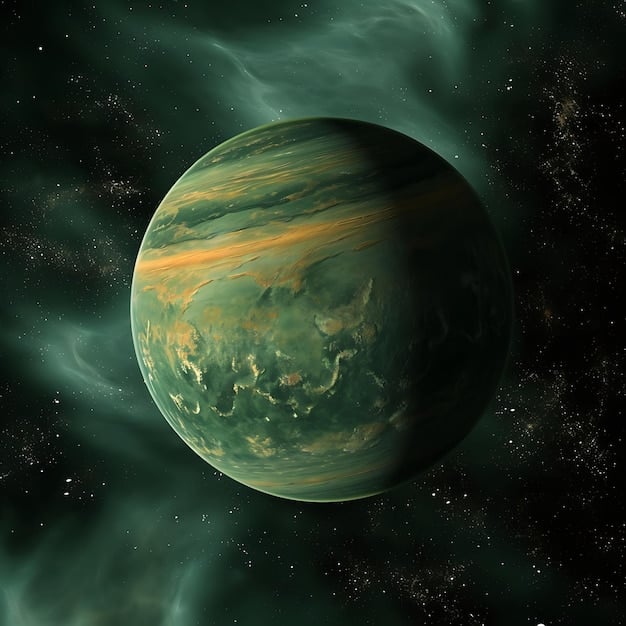Venus Life Discovery: Implications for Extraterrestrial Life Search

What are the implications of the recent discovery of potential signs of life on Venus for the search for extraterrestrial life in the universe? This discovery suggests that life might exist in unexpected environments and expands the scope of potential habitable zones, influencing future astrobiology research and space exploration missions.
The tantalizing possibility of life beyond Earth has always captivated humanity. Recently, the potential discovery of phosphine gas in the Venusian atmosphere, a possible biosignature, has sent ripples of excitement and debate through the scientific community. But what are the implications of the recent discovery of potential signs of life on Venus for the search for extraterrestrial life in the universe?
Does this discovery change our understanding of habitable zones? How might it influence future space exploration endeavors? Let’s delve into the details and consider the broader implications of this intriguing find.
Understanding the Venusian Discovery and Its Context
The initial discovery centered around the detection of phosphine (PH3) in the atmosphere of Venus. On Earth, phosphine is primarily associated with biological activity or certain industrial processes. Thus, finding it on Venus, a planet long considered uninhabitable due to its harsh conditions, raised eyebrows and sparked intense scientific scrutiny. The context of this discovery is crucial to understanding what are the implications of the recent discovery of potential signs of life on Venus for the search for extraterrestrial life in the universe.
The Significance of Phosphine as a Biosignature
Phosphine’s presence is not a definitive sign of life, but it is an anomaly that warrants further investigation. A biosignature is any substance, element, isotope or feature that provides scientific evidence of past or present life. Phosphine fits this description because, under the known chemical conditions of Venus, it is difficult to explain its presence through non-biological means.
Challenges and Criticisms of the Initial Findings
Despite the initial excitement, the discovery has faced considerable scrutiny. Critics have questioned the data processing methods used to detect phosphine, suggesting that the signal might have been overestimated or misinterpreted. Follow-up studies have produced conflicting results, with some failing to detect phosphine at the originally reported levels. This debate highlights the complexities of remote sensing and the challenges of interpreting ambiguous data.
- Re-analysis of the original data.
- Independent observations by other research teams.
- Examination of alternative non-biological sources of phosphine.

The scientific process involves rigorous testing and validation. As scientists continue to analyze the data and conduct new observations, a clearer picture of the situation on Venus will emerge. It is paramount to foster collaboration, transparency, and critical evaluation to build knowledge and move forward.
Expanding the Habitable Zone Concept
Traditionally, the habitable zone is defined as the region around a star where liquid water can exist on a planet’s surface. The Venus findings challenge this notion, suggesting that life might find a way to thrive in unexpected and extreme environments. This fundamentally changes what are the implications of the recent discovery of potential signs of life on Venus for the search for extraterrestrial life in the universe.
Redefining “Habitable”
Venus, with its scorching surface temperatures and toxic atmosphere, was long considered outside the habitable zone. However, the potential presence of phosphine suggests that microbial life could exist in the more temperate upper atmosphere, where conditions are less extreme. This expands the definition of habitable to include regions previously dismissed.
Implications for Other Celestial Bodies
If life can exist in the Venusian atmosphere, it opens the possibility that it could also exist in other harsh environments, such as the atmospheres of gas giants or the subsurface oceans of icy moons like Europa or Enceladus. This dramatically increases the number of potential habitats within our solar system and beyond.
- Atmospheres of gas giants.
- Subsurface oceans of icy moons.
- Planets orbiting red dwarf stars.
The discovery urges scientists to reconsider their assumptions about the conditions necessary for life. Future research should focus on exploring a wider range of environments and searching for unconventional biosignatures that might indicate the presence of life in unexpected places. This paradigm shift can lead to more targeted and fruitful exploration missions.
The Impact on Astrobiology Research
The buzz surrounding Venus has breathed new life into astrobiology, the field dedicated to the search for life beyond Earth. This event has re-energized researchers and sparked new ideas regarding what are the implications of the recent discovery of potential signs of life on Venus for the search for extraterrestrial life in the universe.
New Research Directions and Priorities
The Venus discovery has prompted a re-evaluation of research priorities in astrobiology. Scientists are now focusing on developing new technologies and techniques for detecting biosignatures in extreme environments. There is also increased interest in studying the limits of life on Earth, to better understand the adaptations required for survival in harsh conditions.
Funding and Investment in Space Exploration
The potential for life on Venus has also attracted increased attention from funding agencies and private investors. Space exploration missions to Venus are now being reconsidered, with a focus on directly sampling the atmosphere and searching for more definitive evidence of life. This renewed interest has the potential to accelerate the pace of astrobiological research and expand the scope of space exploration.
This discovery serves as a reminder of the complexity and diversity of the universe. Astrobiology requires a multidisciplinary approach, integrating knowledge from biology, chemistry, geology, and astronomy. Combining diverse expertise can lead to new insights and innovative strategies for the search for extraterrestrial life. What are the implications of the recent discovery of potential signs of life on Venus for the search for extraterrestrial life in the universe? It is now a question with a stronger focus.
Future Space Exploration Missions
Fueled by the Venus discovery, several space agencies and private companies are considering or planning new missions to Venus. These missions aim to further investigate its atmosphere and geology and to search for definitive evidence of life. These missions will directly address what are the implications of the recent discovery of potential signs of life on Venus for the search for extraterrestrial life in the universe.
Proposed Venus Missions
Several proposed missions are designed to study the Venusian atmosphere and surface in detail. These include NASA’s DAVINCI+ and VERITAS missions, as well as the European Space Agency’s EnVision mission. These missions will use a variety of instruments, including spectrometers, radar, and atmospheric probes, to gather data about Venus’s environment. The goal is to understand if Venus is habitable.
The Role of Private Companies
Private space companies are also playing a growing role in Venus exploration. Companies like Rocket Lab are planning low-cost missions to Venus to search for biosignatures in the atmosphere. These private missions can complement government-funded missions, providing more frequent and flexible opportunities for exploration. The future of astrobiology might heavily depend on such endeavors.
- Atmospheric sampling and analysis.
- High-resolution mapping of the surface.
- Deployment of long-duration probes.

Future space exploration missions will provide valuable data about Venus and its potential for life. Collaboration between space agencies, private companies, and research institutions is essential to maximize the scientific return from these missions. These should inform public opinion and stimulate interest in further deep space exploration.
Ethical and Philosophical Considerations
The discovery of potential life on Venus raises important ethical and philosophical questions about the search for and potential contact with extraterrestrial life. What are the implications of the recent discovery of potential signs of life on Venus for the search for extraterrestrial life in the universe in terms of ethics?
Planetary Protection
Planetary protection is a set of principles aimed at preventing the contamination of other celestial bodies with Earth-based life. If life exists on Venus, it is crucial to protect it from contamination during exploration missions. This requires careful sterilization of spacecraft and the development of protocols to minimize the risk of introducing Earth microbes to Venus.
The Meaning of Life Beyond Earth
The discovery of life beyond Earth would have profound philosophical implications. It would challenge our understanding of our place in the universe and raise questions about the origin and evolution of life. It would also prompt ethical considerations about how we should interact with other forms of life, even if those forms are microbial. New legal frameworks regarding space exploration might be needed to face these new ethical dilemmas. What are the implications of the recent discovery of potential signs of life on Venus for the search for extraterrestrial life in the universe from this point of view?
These considerations require ongoing dialogue between scientists, ethicists, policymakers, and the public. The search for life beyond Earth is not just a scientific endeavor but a human one, with implications that extend far beyond the laboratory.
| Key Point | Brief Description |
|---|---|
| 🧪 Phosphine Detection | Anomalous presence in Venusian atmosphere sparks life possibility. |
| 🌍 Habitable Zone | Challenges traditional definition, suggesting life in extreme environments. |
| 🚀 Future Missions | Proposed missions aim to investigate Venus’s atmosphere and surface further. |
| 🤔 Ethical Concerns | Raises ethical questions about planetary protection and interaction with extraterrestrial life. |
Frequently Asked Questions
The primary evidence is the detection of phosphine gas in the Venusian atmosphere, which, on Earth, is mainly produced by biological processes. Its unexpected presence suggests potential life, though other explanations are being explored.
Venus has extremely high surface temperatures, a dense and toxic atmosphere composed mainly of carbon dioxide, and clouds of sulfuric acid. These conditions make it very difficult for life as we know it to survive on the surface.
The potential discovery expands the scope of habitable zones and suggests that life might exist in unexpected environments. This influences future astrobiology research and space exploration missions, orienting them towards harsh conditions.
Planned missions include NASA’s DAVINCI+ and VERITAS, and the European Space Agency’s EnVision. These missions aim to study Venus’s atmosphere and surface in detail, searching for more definitive evidence of life.
Ethical considerations include planetary protection, ensuring we do not contaminate any potential Venusian life with Earth-based organisms. It also raises questions about our ethical responsibilities towards any extraterrestrial life forms.
Conclusion
The potential discovery of life on Venus is a reminder of the vastness and mystery of the universe. While the findings are still preliminary and require further confirmation, they have already had a profound impact on the field of astrobiology. What are the implications of the recent discovery of potential signs of life on Venus for the search for extraterrestrial life in the universe? It’s a question that continues to drive scientific inquiry and pushes us to explore the cosmos.





